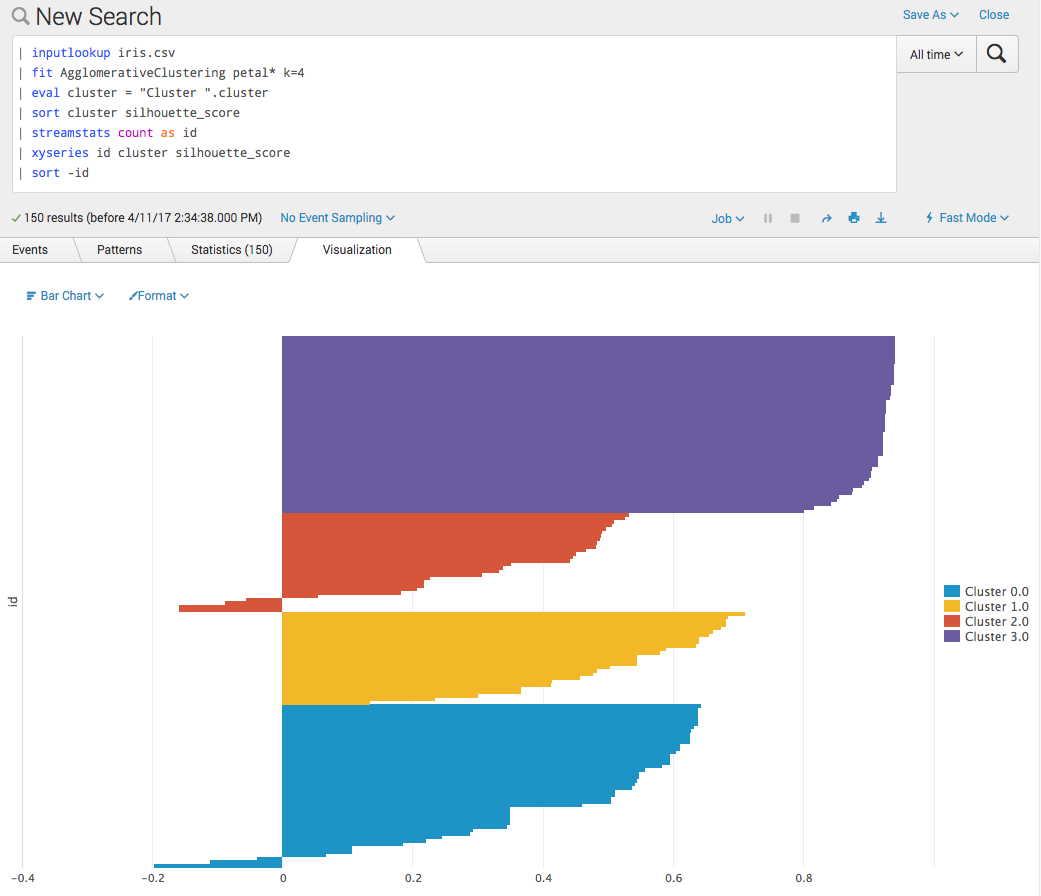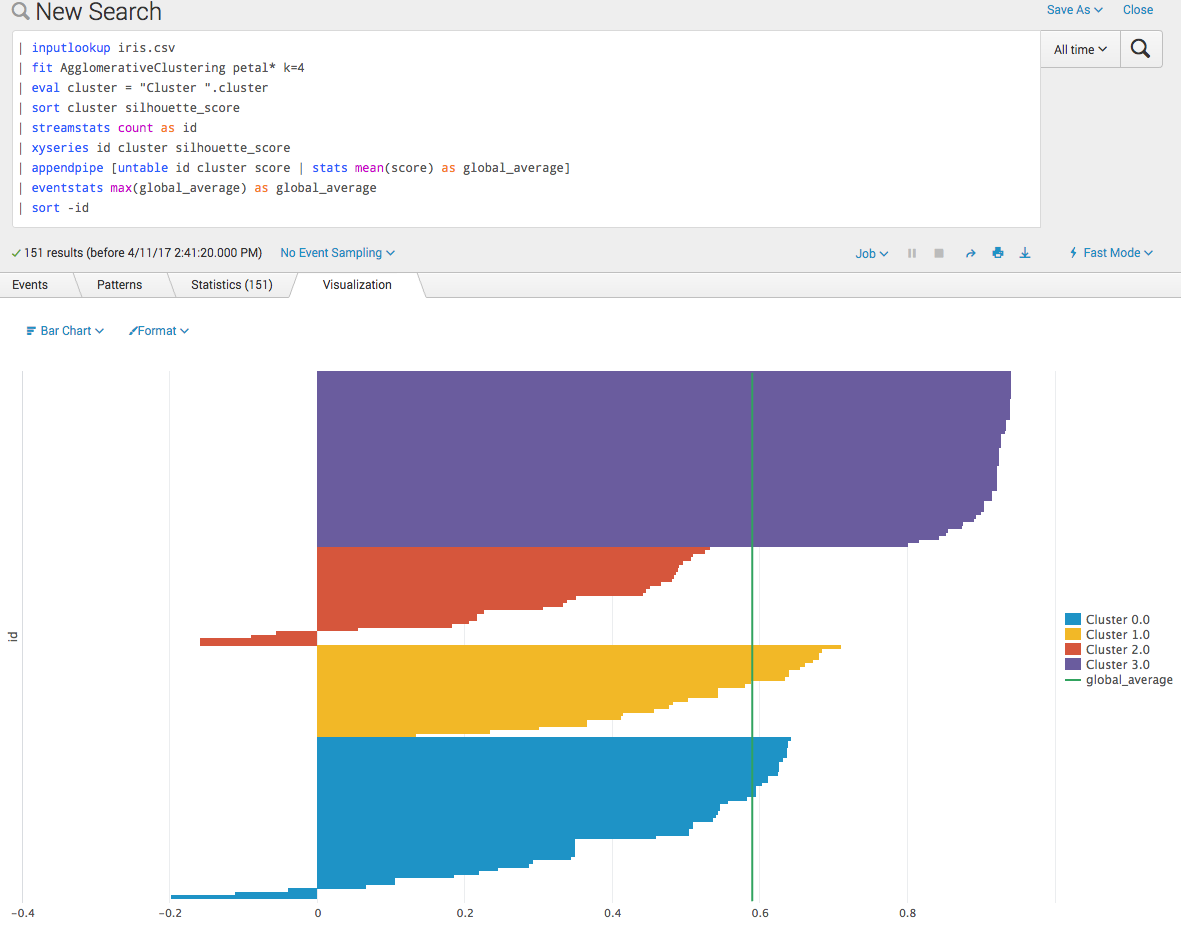Agglomerative Clustering example
You can add custom algorithms to the MLTK app. This example adds the AgglomerativeClustering algorithm from scii-kit learn. You can use the scikit-learn silhouette_samples function to create silhouette scores for each cluster label. For more information see the scikit-learn documentation: https://scikit-learn.org/stable/user_guide.html
Add the Agglomerative Clustering algorithm
Follow these steps to add the Agglomerative Clustering algorithm.
- Register the Agglomerative Clustering algorithm.
- Create the Python file.
- Define the class.
- Define the init method.
- Define the fit method.
Register the Agglomerative Clustering algorithm
Register the algorithm in algos.conf using one of the following methods.
Register the algorithm using the REST API
Use the following curl command to register using the REST API:
$ curl -k -u admin:<admin pass> https://localhost:8089/servicesNS/nobody/Splunk_ML_Toolkit/configs/conf-algos -d name="AgglomerativeClustering"
Register the algorithm manually
Modify or create the algos.conf file located in $SPLUNK_HOME/etc/apps/Splunk_ML_Toolkit/local/ and add the following stanza to register your algorithm:
[AgglomerativeClustering]
When you register the algorithm with this method, you must restart Splunk Enterprise.
Create the Python file
Create the Python file in the algos folder. For this example, you create $SPLUNK_HOME/etc/apps/Splunk_ML_Toolkit/bin/algos/AgglomerativeClustering.py
Ensure any needed code is imported. Import the convert_params utility and df_util module.
import numpy as np from sklearn.metrics import silhouette_sample from sklearn.cluster import AgglomerativeClustering as AgClustering from base import BaseAlgo from util.param_util import convert_params from util import df_util
Define the class
Inherit from the BaseAlgo. The class name is the name of the algorithm.
class AgglomerativeClustering(BaseAlgo): """Use scikit-learn's AgglomerativeClustering algorithm to cluster data."""
Define the init method
The __init__ method passes the options from the search to the algorithm:
- Check for valid syntax.
- Convert parameters.
- The
convert_paramsutility tries to convert parameters into the declared type. - In this example, you pass
k=<some integer>to the estimator . When it is passed in via the search query, it is treated as a string. - The
convert_paramsutility tries to convert thekparameter to an integer and produces an error if it cannot. - The
aliaslets users define the number of clusters withkinstead ofn_clusters.
- The
- Attach the initialized estimator to self with the converted parameters.
def __init__(self, options):
feature_variables = options.get('feature_variables', {})
target_variable = options.get('target_variable', {})
# Ensure fields are present
if len(feature_variables) == 0:
raise RuntimeError('You must supply one or more fields')
# No from clause allowed
if len(target_variable) > 0:
raise RuntimeError('AgglomerativeClustering does not support the from clause')
# Convert params & alias k to n_clusters
params = options.get('params', {})
out_params = convert_params(
params,
ints=['k'],
strs=['linkage', 'affinity'],
aliases={'k': 'n_clusters'}
)
# Check for valid linkage
if 'linkage' in out_params:
valid_linkage = ['ward', 'complete', 'average']
if out_params['linkage'] not in valid_linkage:
raise RuntimeError('linkage must be one of: {}'.format(', '.join(valid_linkage)))
# Check for valid affinity
if 'affinity' in out_params:
valid_affinity = ['l1', 'l2', 'cosine', 'manhattan',
'precomputed', 'euclidean']
if out_params['affinity'] not in valid_affinity:
raise RuntimeError('affinity must be one of: {}'.format(', '.join(valid_affinity)))
# Check for invalid affinity & linkage combination
if 'linkage' in out_params and 'affinity' in out_params:
if out_params['linkage'] == 'ward':
if out_params['affinity'] != 'euclidean':
raise RuntimeError('ward linkage (default) must use euclidean affinity (default)')
# Initialize the estimator
self.estimator = AgClustering(**out_params)
The convert_params utility is small and simple. When it is passed parameters from the search, they're received as strings. If you want to pass them to an algorithm or estimator, you need to convert them to the proper type (e.g. an int or a boolean). The function does exactly this.
So when convert_params is called, it will convert the parameters from the search to the proper type if they are one of the following:
- float
- int
- string
- boolean
Define the fit method
The fit method is where you compute the correlations. And then returns the DataFrame.
- To merge predictions with the original data, first make a copy.
- Use the
df_util'sprepare_featuresmethod. - After making the predictions, create an output dataframe. Use the nans mask returned from
prepare_featuresto know where to insert the rows if there were any nulls present. - Lastly, merge with the original dataframe and return.
def fit(self, df, options):
"""Do the clustering and merge labels with original data."""
# Make a copy of the input data
X = df.copy()
# Use the df_util prepare_features method to
# - drop null columns & rows
# - convert categorical columns into dummy indicator columns
# X is our cleaned data, nans is a mask of the null value locations
X, nans, columns = df_util.prepare_features(X, self.feature_variables)
# Do the actual clustering
y_hat = self.estimator.fit_predict(X.values)
# attach silhouette coefficient score for each row
silhouettes = silhouette_samples(X, y_hat)
# Combine the two arrays, and transpose them.
y_hat = np.vstack([y_hat, silhouettes]).T
# Assign default output names
default_name = 'cluster'
# Get the value from the as-clause if present
output_name = options.get('output_name', default_name)
# There are two columns - one for the labels, for the silhouette scores
output_names = [output_name, 'silhouette_score']
# Use the predictions and nans-mask to create a new dataframe
output_df = df_util.create_output_dataframe(y_hat, nans, output_names)
# Merge the dataframe with the original input data
df = df_util.merge_predictions(df, output_df)
return df
The prepare feature is just one of the utility methods in df_util.py.
prepare_features(X, variables, final_columns=None, get_dummies=True)
This method defines conventional steps to prepare features:
- drop unused columns - drop rows that have missing values - optionally (if get_dummies==True) - convert categorical fields into indicator dummy variables - optionally (if final_column is provided) - make the resulting dataframe match final_columns
Arguments:
X (dataframe): input dataframe variables (list): column names final_columns (list): finalized column names - default is None get_dummies (bool): indicate if categorical variable should be converted - default is True
Returns:
X (dataframe): prepared feature dataframe nans (np array): boolean array to indicate which rows have missing values in the original dataframe columns (list): sorted list of feature column names
For the output shape in this example, two columns are added rather than one. Make sure that the output_names passed to the create_output_dataframe method has two names, not one.
End-to-end example
This Agglomerative Clustering example covers the following tasks:
- Using the
BaseAlgoclass - Validating search syntax
- Converting parameters
- Using
df_utilutilities - Adding a custom metric to the algorithm
import numpy as np
from sklearn.cluster import AgglomerativeClustering as AgClustering
from sklearn.metrics import silhouette_samples
from base import BaseAlgo
from util.param_util import convert_params
from util import df_util
class AgglomerativeClustering(BaseAlgo):
"""Use scikit-learn's AgglomerativeClustering algorithm to cluster data."""
def __init__(self, options):
feature_variables = options.get('feature_variables', {})
target_variable = options.get('target_variable', {})
# Ensure fields are present
if len(feature_variables) == 0:
raise RuntimeError('You must supply one or more fields')
# No from clause allowed
if len(target_variable) > 0:
raise RuntimeError('AgglomerativeClustering does not support the from clause')
# Convert params & alias k to n_clusters
params = options.get('params', {})
out_params = convert_params(
params,
ints=['k'],
strs=['linkage', 'affinity'],
aliases={'k': 'n_clusters'}
)
# Check for valid linkage
if 'linkage' in out_params:
valid_linkage = ['ward', 'complete', 'average']
if out_params['linkage'] not in valid_linkage:
raise RuntimeError('linkage must be one of: {}'.format(', '.join(valid_linkage)))
# Check for valid affinity
if 'affinity' in out_params:
valid_affinity = ['l1', 'l2', 'cosine', 'manhattan',
'precomputed', 'euclidean']
if out_params['affinity'] not in valid_affinity:
raise RuntimeError('affinity must be one of: {}'.format(', '.join(valid_affinity)))
# Check for invalid affinity & linkage combination
if 'linkage' in out_params and 'affinity' in out_params:
if out_params['linkage'] == 'ward':
if out_params['affinity'] != 'euclidean':
raise RuntimeError('ward linkage (default) must use euclidean affinity (default)')
# Initialize the estimator
self.estimator = AgClustering(**out_params)
def fit(self, df, options):
"""Do the clustering & merge labels with original data."""
# Make a copy of the input data
X = df.copy()
# Use the df_util prepare_features method to
# - drop null columns & rows
# - convert categorical columns into dummy indicator columns
# X is our cleaned data, nans is a mask of the null value locations
X, nans, columns = df_util.prepare_features(X, self.feature_variables)
# Do the actual clustering
y_hat = self.estimator.fit_predict(X.values)
# attach silhouette coefficient score for each row
silhouettes = silhouette_samples(X, y_hat)
# Combine the two arrays, and transpose them.
y_hat = np.vstack([y_hat, silhouettes]).T
# Assign default output names
default_name = 'cluster'
# Get the value from the as-clause if present
output_name = options.get('output_name', default_name)
# There are two columns - one for the labels, for the silhouette scores
output_names = [output_name, 'silhouette_score']
# Use the predictions & nans-mask to create a new dataframe
output_df = df_util.create_output_dataframe(y_hat, nans, output_names)
# Merge the dataframe with the original input data
df = df_util.merge_predictions(df, output_df)
return df
Silhouette plot examples
You can now make a silhouette plot as shown in the following search. These can be useful for selecting the number of clusters if not already known:
| inputlookup iris.csv
| fit AgglomerativeClustering petal* kk=4
| eval cluster = "Cluster ".cluster
| sort cluster silhouette_score
| streamstats count as id
| xyseries id cluster silhouette_score
| sort -id
This image shows the example search in a Splunk search tab:
The global average can be a valuable addition to your plot. This has been added to the following search as a chart overlay:
| inputlookup iris.csv
| fit AgglomerativeClustering petal* kk=4
| eval cluster = "Cluster ".cluster
| sort cluster silhouette_score
| streamstats count as id
| xyserarch>ies id cluster silhouette_score
| appendpipe [untable id cluster score | stats mean(score) as global_average]
| eventstats max(global_average) as global_average
| sort -id
This image shows the example search in a Splunk search tab:
| Correlation Matrix example | Support Vector Regressor example |
This documentation applies to the following versions of Splunk® Machine Learning Toolkit: 5.1.0, 5.2.0, 5.2.1, 5.2.2, 5.3.0, 5.3.1, 5.3.3, 5.4.0, 5.4.1, 5.4.2, 5.5.0, 5.6.0


 Download manual
Download manual
Feedback submitted, thanks!